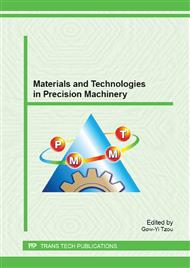p.10
p.16
p.22
p.29
p.36
p.44
p.55
p.62
p.69
Interference of Die Equipment for Hexagonal Flange Nut Forming Process
Abstract:
Most cold forging die insert materials are powder sintered tungsten steel materials, which can hardly bear the circumferential tension and stress that the die insert longitudinal fracture is easily caused. For this reason, this study intends to investigate effects of die insert pre-stress resulted from shrink fit interference on the die to prevent the product accuracy and service life from being reduced due to the die failure in the forging process. The die effective stress distribution is also calculated in this study, and the interference is added between tungsten steel die inserts and cases to prevent tungsten steel from being damaged by the circumferential stress. The die stress distribution caused by common shrink fit interference in the industry is also investigated. The optimal interference acquired under the design criteria of decreasing equivalent stress presents 0.4%, 0.2%, 0.1%, 0.8%, and 0.1% at different stages. The research results could be the reference to select the optimal parameter for the die design and further shorten the product development effectiveness and reduce the costs.
Info:
Periodical:
Pages:
36-43
Citation:
Online since:
September 2015
Authors:
Keywords:
Price:
Сopyright:
© 2015 Trans Tech Publications Ltd. All Rights Reserved
Share:
Citation:


